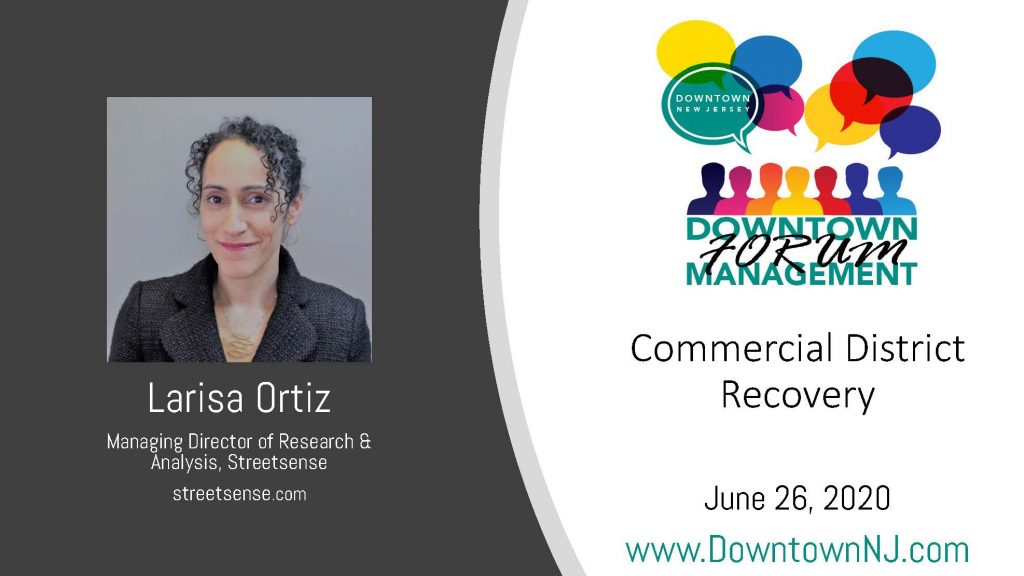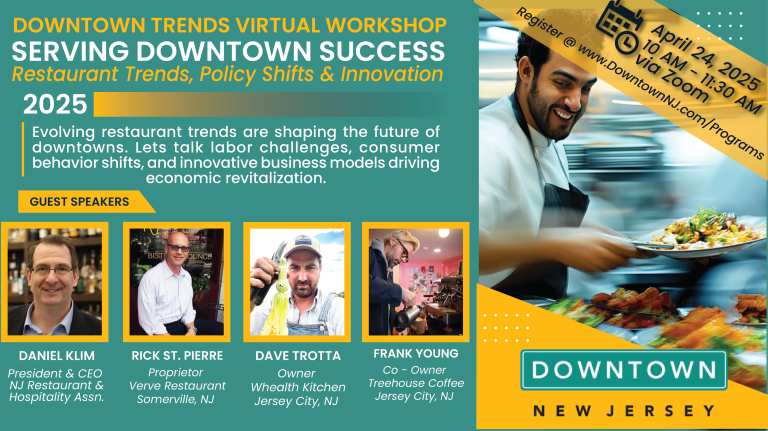Commercial District Recovery
Courtenay D. Mercer, PP, AICP
Executive Director, Downtown New Jersey
Rachael Thompson Panik
Associate Planner, Mercer Planning Associates
June 26, 2020
Downtown New Jersey provided a series of virtual opportunities for downtown managers, economic development professionals, and public officials to exchange ideas about best practices related to downtown economic development in light of the COVID-19 crisis.
Small businesses in communities nationwide are facing the risk of permanent closure. To help address these challenges, Streetsense in partnership with LISC, created the Commercial District Recovery Guide that provides place-based organizations and intermediary partners focused on community economic development with a curated roadmap for action to support COVID-19 recovery efforts in downtowns and commercial districts. This forum was be led by Larisa Ortiz, Managing Director of Research & Analysis at Streetsense, who provided an overview of the guide to kick-off an exchange of ideas among forum participants.
Watch Video:
View Recovery Guide>
View Powerpoint>
To begin the discussion, Downtown New Jersey Executive Director, Courtenay Mercer, shared some statistics from the Governor’s Restart & Recovery Council to lay the framework of perceptions about re-opening and expectations for recovery. A recent McKinsey survey indicated that most New Jersey residents do not plan to resume normal activities even after the stay-at-home restrictions are lifted. According to the US Census Bureau’s most recent Small Business Pulse Survey, the number of small businesses in the state with a month or more of operating cash on hand has increased since May, which is likely attributed to the distribution of PPP and other relief funds. In addition, small businesses now believe that it will take longer for business to resume to normal levels than in previously anticipated. In early May, more than 50% of respondents thought operations would return to normal in less than 6 months, while only a third felt that way by early June.
Larissa Ortiz then provided an overview of Commercial District Recovery Guide, which establishes a blueprint for reopening and recovery. Recent research found that 25-36% of small business will close permanently. Restaurants need to operate at 70-75% capacity to survive, and many may only be serving 20-40% of capacity for the foreseeable future. Downtown managers and retail owners are feeling the impacts of this pandemic, which will ultimately be dubbed one of the most significant economic disasters the world has faced in contemporary history. The Commercial Recovery Guide puts forth a disaster framework for communities to think about and structure their recovery efforts.
The Guide looks at recovery over three phases: phase 1 – response to the immediate threats of the pandemic; phase 2 – recovery from the damage it has caused; and phase 3 – planning and preparing for a more resilient future. All phases of emergency management are critical to ensuring sustained recovery. Right now, most communities are in some part of phase 2 recovery, and should be focusing efforts on outreach, data collection, and implementation.
Nearly all Business Improvement Districts (BIDs) and downtown organizations implemented the first important step in recovery by conducting outreach to business owners and raising awareness among the broader community. As we move into the next phase, districts should spend time thinking about how to share their story – both what they have done to respond to the disaster and what they are doing now, including what stores are open, fundraisers, initiatives, etc.
Downtown leaders should also consider assigning a disaster recovery coordinator and forming a district-wide recovery team that meets regularly to create dynamic solutions in a nimble manner. Downtown commercial district leaders should also be creative in the ways they are measuring the impact of the pandemic and accompanying recession. Many things that downtown organizations take for granted right now – how customers have shopped, their preferences, etc. – are changing, and it is important to track and measure those changes when possible. If organizations do not have the capacity to collect data, they should form partnerships with individuals, businesses, or organizations that can. Surveys, in particular, can be helpful resources in tracking how people, places, and capital are changing. The Guide recommends conducting an audit of existing data sources that can be leveraged now, and then find ways to gather additional data to fill in any gaps. These data sources and resulting findings are crucial for communicating to stakeholders and potential funders why the downtown commercial district is pursuing certain strategies.
Finally, during the recovery phase, commercial districts should continue to focus on the implementation of practices that allow businesses to reopen in a manner that keeps customers and employees safe. A clean, sanitary environment is of major importance to consumers. Commercial districts and business should not only think about safe entry into buildings, they should also implement changes to the public realm to ensure the district feels both safe and welcoming.
In addition to the Commercial District Recovery Guide, Streetsense published a Restaurant Relaunch Guide and a Hotel Survival Guide.
Discussion and Q&A:
- If a town does not have a BID or downtown organization, what can they do to help local businesses recover despite financial challenges?
Municipalities and their professionals (planner, administrator, economic development director) have their own role to play. They can serve as an intermediary bringing key stakeholders together to identify challenges and offer solutions. Also, municipalities should think of barriers to successful reopening, such as zoning requirements for outdoor seating or other regulatory hurdles.
- There is an interest in conducting “exit interviews” with closing businesses to determine the root cause. Does the Guide provide guidance/a template for that type of interview?
The Guide does not include a template, but some questions to ask may be: “How much cash did you have on hand before COVID?”; “Where did you find yourself as you closed, in terms of sales, cash on hand, revenue, etc.?”; and other questions that will help provide a clear picture of before and after.
- Are you seeing an increase in QR codes for ordering?
Not yet, but that doesn’t mean it is not happening.
- Outdoor dining and retail have a short time horizon in our climate. Participants discussed possibilities for extending the season.
Heaters are an option, but they are expensive to buy and run. People could also make use of tents. These may not be allowed under existing regulations though, so towns should be preparing now to ensure there are no issues for businesses in the coming months.
- For larger public gatherings, how can you limit the number of people to meet executive orders/guidelines? Are there regulatory issues with hosting a large private event (where you are ticketing)?
It seems likely that these events will not happen as planned given the current projections of the virus. Most have already cancelled these events. Downtown organizations and towns can still be creative here. If the goal of those events was to support local businesses and drive customers downtown, then leaders can look for other ways to promote the district through branding and marketing.Some towns are looking for ways to directly support businesses through grants. Others are footing the bill to create/beautify outdoor space for commercial use. For example, Jersey City is taking out the permits, and then programming space for the downtown businesses to use. This prevents the BIDs and businesses from having to obtain liability insurance themselves.
- How are people hosting town meetings or large-scale public meetings during this time?
Many organizations are pivoting to virtual activities and making use of stakeholder advisory committees to help determine how best to reach disadvantaged communities. Where outreach cannot be virtual, they will be very strictly monitored for social distancing, and the number of people at those engagement activities will be limited.
- Discussion about sidewalk dining ordinances:
In 2015, Perth Amboy enabled sidewalk dining city-wide. With COVID-19’s impact on restaurants, the city has waived all fees and is turning around permits in 24-hours. The code enforcement office provides feedback on how many seats a restaurant can have outside. This has helped restaurants around the city to offset capacity reductions.A participant suggested that towns should also consider helping restaurants establish dining in front of businesses that are closed; both by ensuring zoning allows it, and by helping negotiate with the property’s landlord.
- How can a BID or chamber work together with a town when the elected officials do not recognize them as a resource?
All situations are different, but this gets back to leadership skills. Conversations should center around finding common ground and shared goals as a first step. Try to identify who the “bottlenecks” are, and then bring them to the table.Sometimes, more drastic measures are necessary. In a recent example, a BID organized their constituents to speak during a council meeting to request movement by the body with regard to street closures and parklets to enable businesses to expand outside.
- Discussion about resources:The DBIZ funding has been reallocated and will not be available to districts. The NJEDA expanded their microloan program to non-profits. The program provides for 10% loan forgiveness (which equates to roughly the amount of interest that would be paid). Districts could consider using this program to fund efforts to support their small business, such as bulk buys of PPE, creating parklets, hiring professionals to assist with marketing, online merchandising, etc.


